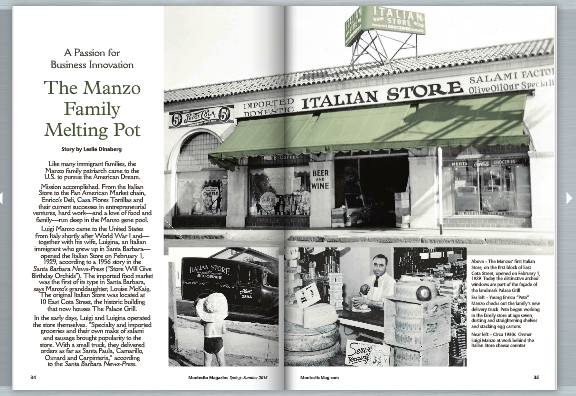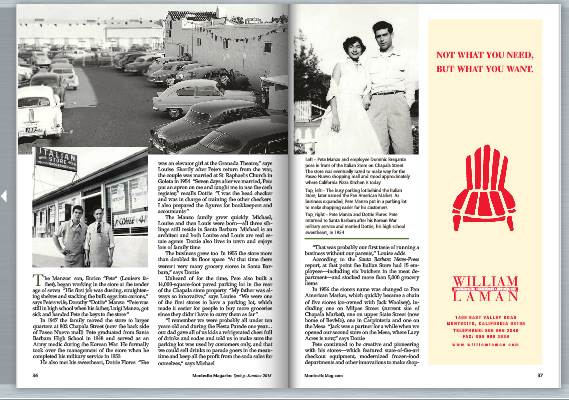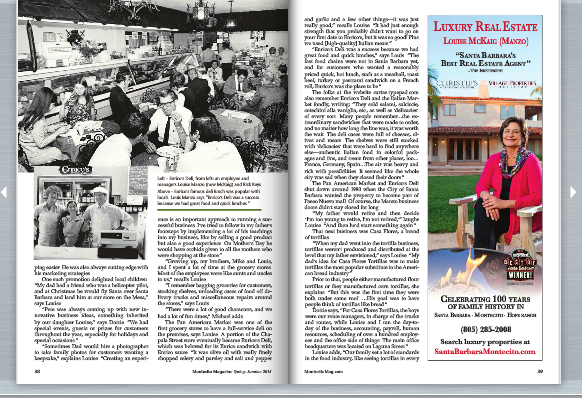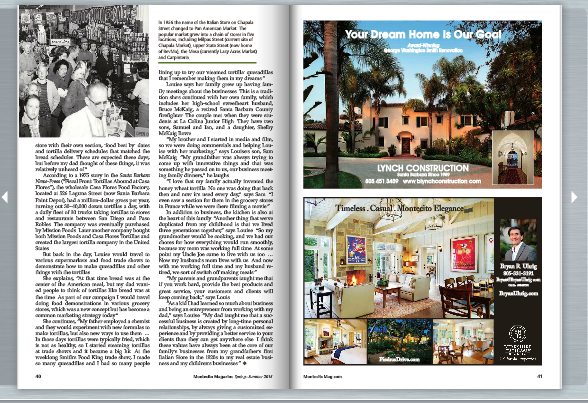The Manzo-McKaig Melting Pot
By Leslie Dinaberg

Courtesy Montecito Magazine
Like many immigrant families, the Manzo-McKaig patriarch came to the U.S. to pursue the American Dream.
Mission accomplished. From the Italian Store to the Pan-American Market chain, Enrico’s Deli and Casa Flores Tortillas, to their current successes in entrepreneurial ventures, hard work—and a love of food and family—run deep in the Manzo-McKaig gene pool.
Luigi Manzo came to the United States from Italy shortly after World War I, and together with his wife Luigina, opened the Italian Store, on February 1, 1929, according to a 1956 story in the Santa Barbara News-Press (“Store Will Give Birthday Orchids”). The imported food market was the first of its type in Santa Barbara, says Manzo’s granddaughter, Louise McKaig, The original Italian Store was located at 10 E. Cota St., the historic building that now houses the Palace Restaurant.
In the early days, Luigi and Luigina operated the store themselves. “Specialty and imported groceries and their own make of salumi and sausage brought popularity to the store. With a small truck they delivered orders as far as Santa Paula, Camarillo, Oxnard and Carpinteria,” according to the Santa Barbara News-Press.
“My Grandma always told me she came through Ellis Island [also from Italy] when she was nine,” says Louise. “She said that her father and his brother went to work in the coal mines in Oklahoma.” According to the 1930 U.S. Census records, Luigina arrived in this country in 1915, and classified herself as an “unpaid worker, member of the family” at the “Family Grocery Store” in Santa Barbara.
The Manzo’s son Enrico “Pete” (Louise’s father) also began working at the store at the tender age of seven. “His first job was dusting, straightening shelves, and stacking the bulk eggs into cartons,” says Pete’s wife Dorothy “Dottie” Manzo. “Pete was still in high-school when his father, Luigi Manzo, got sick and handed Pete the keys to the store. ”

Courtesy Montecito Magazine
In 1947, the family moved the store to larger quarters at 802 Chapala St. (now the back side of Paseo Nuevo Mall). Enrico graduated from Santa Barbara High School in 1948, and served as an Army medic during the Korean War. He formally took over the management of the store when he completed his military service in 1953.
He also came back to home to his sweetheart, Dorothy “Dottie” Flores. “She was an elevator girl at the Granada Theatre,” says Louise. Shortly after Enrico’s return from the war, the couple was married at St. Raphael’s Church in Goleta in 1954. “Seven days after we married, Pete put an apron on me and taught me to use the cash register,” recalls Dottie. “I was the head checker and was in charge of training the other checkers. I also prepared the figures for bookkeepers and accountants.”
The Manzo family grew quickly. Michael, Louise and then Louis were born—all three siblings still reside in Santa Barbara. Michael is an architect and Louis and Louise are both real estate agents. Dottie also lives in town and enjoys lots of family time.
The business grew too. In 1955 the store more than doubled its floor space. “At that time there weren’t very many grocery stores in Santa Barbara,” says Dottie.
Unheard of for the time, Enrico also built a 14,000-square-foot paved parking lot in the rear of the Chapala store. “My father was always so innovative,” says Louise. “We were one of the first stores to have a parking lot, which made it easier for people to buy more groceries since they didn’t have to carry them as far.”

Courtesy Montecito Magazine
“I remember we were probably all under ten years old and during the Fiesta Parade one year … our dad gave all of us kids a refrigerated chest full of drinks and sodas and told us to make sure the parking lot was used by customers only, and that we could sell drinks to parade goers in the meantime and keep all the profit from the soda sales for ourselves, says Michael.
“That was probably our first taste of running a business without our parents,” says Louise.
According to the Santa Barbara News-Press report, at that point the Italian Store had 15 employees—including six butchers in the meat department—and stocked more than 5,000 grocery items.
In 1956, they changed the store’s name to Pan American Market, which quickly became a chain of five stores (co-owned with Jack Woolsey), including one on Milpas Street, where Chapala Market is now, one on upper State Street where Bev Mo is now, one in Carpinteria, and one on the Mesa. “Jack was a partner for a while when we opened our second store on the Mesa, where Lazy Acres is now,” says Dottie.
Enrico continued to be creative and pioneering with his stores—which featured state-of-the-art checkout equipment, modernized frozen-food departments and other innovations to make shopping easier. He was also always cutting edge with his marketing strategies.
One such promotion delighted local children. “We had a store in Carpinteria,” says Louise, “and my dad had this friend who was a helicopter pilot fly over the store dressed as Santa for Christmas.” Helicopter Santa also visited the Mesa store, according to Dottie.
This kind of attention-getting stunt wasn’t being done at that time; it was unheard of, Louise says.
“Pete was always coming up with new innovative business ideas, something inherited by our daughter Louise,” says Dottie. “We had special events, guests, or prizes for customers throughout the year especially for holidays and special occasions.”
“One year, my dad brought Engineer Bill, the famous kids TV show host, to our Pan American Market in Carpinteria and publicized it to bring new customers. Engineer Bill would be my kids’ generation’s version of Mr. Rogers,” explains Louise. “Sometimes Dad would hire a photographer to take family photos for customers wanting a keepsake. Creating an experience is an important approach to running a successful business. I’ve tried to follow in my father’s footsteps by implementing a lot of his teachings into my business like by selling a good product but also a good experience. On Mother’s Day he would have orchids given to all the mothers who were shopping at the store.”

Courtesy Montecito Magazine
“Growing up, my brothers, Mike and Louis and I spent a lot of time at the grocery stores. Most of the employees were like aunts and uncles to us,” recalls Louise.
“I remember bagging groceries for customers, stocking shelves, unloading cases of food off delivery trucks and miscellaneous repairs around the stores, ” says Louis.
“There were a lot of good characters and we had a lot of fun times,” says Michael.
“One time there was a butcher who wasn’t very nice to us. My dad suggested we give him ‘Happy Pills.’ So the next time he wasn’t being nice, my brothers and I made a little jar with M&Ms and wrote ‘Happy Pills’ on it,” says Louise.
“After that he was a lot nicer to us,” adds Michael.
The family business ethos was backed up with innovative business strategies. For example, the Pan-American Market was also one of the first grocery stores to have a full service deli on the premises, says Louise. A portion of the Chapala Street store eventually became Enrico’s Deli, which was beloved for its Enrico sandwich with Enrico sauce. “It was olive oil with really finely chopped celery and parsley and salt and pepper and garlic and a few other things—it was just really good,” recalls Louise. “It had just enough strength that you probably didn’t want to go on your first date to Enrico’s, but it was so good! Plus, we used really good Italian meats.”
“Enrico’s Deli was a success because we had great food and quick lunches,” says Louis. “The fast food chains were not in Santa Barbara yet, and for customers that wanted a reasonably priced, quick, hot lunch, such as a meatball, roast beef, turkey or pastrami sandwich on a French roll, Enrico’s was the place to be.”
The folks at the website cartastypepad.com also remember Enrico’s Deli and the Italian Market fondly, writing: “They sold salami, salciccie, cotechini alla vaniglia, etc, as well as ‘delicacies’ of every sort. Many people remember… the extraordinary sandwiches that were made to order, and no matter how long the line was, it was worth the wait. The deli cases were full of cheeses, olives, and meats. The shelves were still stocked with “delicacies” that were hard to find anywhere else – authentic Italian food in colorful packages and tins, and treats from other places, too … France, Germany, Spain …The air was heavy and rich with possibilities. It seemed like the whole city was sad when they closed their doors.”
Of course, the Manzo business doors didn’t stay closed for long.
“My father would retire and then decide ‘I’m too young to retire, I’m not retired,'” laughs Louise. “And then he’d start something again.”
“We sold the stores because we wanted to go into our next businesses,” says Dottie.
That next business was Casa Flores, a brand of tortillas.
“When my dad went into the tortilla business, tortillas weren’t produced and distributed at the level that my father envisioned,” says Louise. “My dad’s idea for Casa Flores Tortillas was to make tortillas the most popular substitute to the American bread industry.”
Prior to that, people either manufactured flour tortillas or they manufactured corn tortillas, she explains. “But this was the first time they were both under same roof. … His goal was to have people think of tortillas like bread.”
“For Casa Flores Tortillas the boys were our route managers, in charge of the trucks and routes while Louise and I ran the day-to-day of the business, accounting, payroll, human resources, scheduling of over a hundred employees, and the office side of things. The main office headquarters were located on Laguna Street,” says Dottie.
“Our family set a lot of standards in the food industry like seeing tortillas in every store with their own section, ‘food best by’ dates, and tortilla delivery schedules that matched the bread schedules, ” says Louise. “These are expected these days but before my dad thought of these things it was relatively unheard of.”
She continues, “He was very smart. He gave people things that no one else was getting. For example, Hidden Valley Ranch Dressing was new then, and he sold a lot of that. One of the first distributors was a family friend. When our family opened the first Enrico’s Deli, people could design their sandwich with a quarter pound of meat, their choice of bread, their choice of toppings, a salad choice plus a side green salad with Ranch dressing. As a child I remember lines out the door every day at lunchtime. The new deli and the new salad dressing were a very big hit in Santa Barbara.”
According to a 1975 story in the Santa Barbara News-Press (“Fiscal Front: Tortillas Abound at Casa Flores”), the wholesale Casa Flores Food Factory, located at 526 Laguna St. (now Santa Barbara Paint Depot), had a million dollar gross per year, turning out 30-40,000 dozen tortillas a day, with a daily fleet of 30 trucks taking tortillas to stores and restaurants between San Diego and Paso Robles. The company was eventually purchased by Mission Foods, which is now the number one tortilla company in the United States.
But back in the day, Louise would travel to various supermarkets and food trade shows to demonstrate how to make quesadillas and other things with the tortillas.
She explains, “At that time, bread was at the center of the American meal, but my dad wanted people to think of tortillas like bread was at the time. As part of our campaign I would travel doing food demonstrations in various grocery stores, which was a new concept but has become a common marketing strategy today.”
She continues, “My father employed a chemist and they would experiment with new formulas to make tortillas but also new ways to use them. … In those days, tortillas were typically fried, which is not as healthy, so I started steaming tortillas at trade shows and it became a big hit. I was running our tortilla booth at a big Smith’s Food King trade show in Salt Lake City and every day we had a long line of people wanting to taste our new healthier method of ‘steaming tortillas.’ This man kept coming up to me saying, ‘You’re more popular than Miss America!’ I finally asked ‘who is that guy?’ It turned out to be Dee Smith of Smith’s Food King, and Miss America was actually there hosting another booth that wasn’t as popular as ours. That impressed Dee Smith. I made so many quesadillas that week and I had so many people lining up to try our ‘steamed tortilla’ quesadillas that I remember making them in my dreams.”
“I love that my grandpa actually came up with the idea and was the first to do a honey wheat tortilla, no one was doing that back then,” says Louise’s son, Samuel McKaig. “It my mom’s idea to have a little bee on the front of the package.”
He continues, “I think something that added to the company was it wasn’t just my grandpa, [the kids] were always running it for him. The kids ran the operations and the corporate side of things and my grandma did the accounting and the payroll. So it was always a family thing.”
“We learned a lot doing that,” says Louise. “Even just the mind set of you either are building skills and what you don’t know how to do you learn to do because you just keep building on your knowledge, and surround yourself with knowledgeable people too.”
Louise—an agent with Village Properties—says her family grew up having family meetings about the businesses. This is a tradition she’s continued with her own family, which includes her high school sweetheart husband Bruce McKaig, a retired Santa Barbara County Firefighter. The couple actually met when they were students at La Colina Junior High. Louise says she still teases Bruce that he’s not really a native Santa Barbaran because he didn’t move to town till he was six months old. They have two sons, Samuel and Ian, and a daughter, Shelby McKaig Rowe.
“My brother and I started in media and film, so we were doing commercials and helping Louise with her marketing,” says Samuel. “My grandfather was always trying to come up with innovative things and that was something he passed on to us, our business meeting family dinners,” he laughs.
In addition to business, the kitchen is also at the heart of this family. “Another thing that we’ve duplicated from my childhood is that we lived three generations together,” says Louise. “So my grandmother would be cooking and we had our chores for how everything would run smoothly, because my mom was working full time. At some point my Uncle Joe came to live with us too. … Now my husband’s mom lives with us. And now with me working full time and my husband retired we sort of switch off making meals.”
“And we all cook different meals,” adds Samuel. “I married a French person, so we got some different cuisine in there. She cooks a lot.”
Along with the international cuisines of the various family businesses, Louise also had another business coordinating internal programs for travelers who came to Santa Barbara. “I learned all kinds of different skills doing that, ” she says. “You have to, especially when someone can’t communicate in your own language.”
The family legacy of creativity and always working to improve oneself continues to live on in Santa Barbara. “That was something he (Grandpa Enrico) was always teaching (my mother) and he was trying to teach me is being innovative and coming up with the next thing that no one has done before,” says Samuel. “He taught that to Louise and that’s what she uses in her real estate and that’s what she taught me… being creative and pushing the limits.”
“My parents and grandparents taught me that if you work hard, provide the best products and great service your customers and clients will keep coming back,” says Louis.
“Dad taught us to treat our employees and coworkers the way you want to be treated. He always made sure that everyone in the company was taken care of,” says Michael.
“As a kid I had learned so much about business and being an entrepreneur from working with my dad. My dad taught me that a successful business is created by long-time personal relationships, by always giving a customized experience, and by providing a better service to your clients than they can get anywhere else. I think these values have always been at the core of our family’s businesses from my grandfather’s first Italian Store in the 1920s to my real estate business and my children’s businesses. He taught by example that to make a business successful you need people to want to work for you. He helped our employees from top to bottom feel like they were an essential part of a team.”
Originally published in Montecito Magazine, Spring-Summer 2015.









 A spirited toast to all things alcoholic! By
A spirited toast to all things alcoholic! By 



















